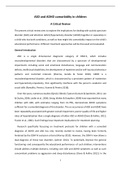ASD and ADHD comorbidity in children
A Critical Review
The present critical review aims to explore the implications for dealing with autistic spectrum
disorder (ASD) and attention deficit/hyperactivity disorder (ADHD) together or separately in
a child who has both conditions, as well as how might this comorbidity impact on the child’s
educational performance. Different treatment approaches will be discussed and evaluated.
General Introduction
ASD is a single dimensional diagnostic category of DSM-5, which includes
neurodevelopmental disorders that are characterized by a spectrum of developmental
impairments including social and emotional disturbances, language and communication
deficits, intellectual disabilities, the development of repetitive and/or self-injurious behaviour
patterns and restricted interests (Sharma, Gonda & Tarazi 2018). ADHD is a
neurodevelopmental disorder, which is characterized by a persistent pattern of inattention
and hyperactivity-impulsivity, that significantly interferes with the person’s academic and
social skills (Ramalho, Pereira, Vicente & Pereira 2018).
Over the years, numerous studies (Gjevik, Eldevik, Fjaeran-Granum & Sponheim, 2011; Lee
& Ousley, 2006; Leyfer et al., 2006; Sinzig, Walter & Doepfner, 2009) have reported that many
children with ASD, with estimates ranging from 31-79%, demonstrate ADHD symptoms
sufficient for a comorbid diagnosis of this disorder. The co-occurrence of ASD and ADHD have
been repeatedly associated with greater overall impairment, poorer quality of life and higher
rates of hospitalization than a single diagnosis of either ASD or ADHD (Davis & Kollins, 2012;
Frazier et al., 2001). Such findings have important implications for treatment planning.
Research specifically focussing on treatment protocols for children with a comorbid
diagnosis of ADHD and ASD has only recently started to evolve, having been formerly
hindered by the DSM-IV exclusion criteria (Murray 2010). However, the DSM-V now allows a
dual-diagnosis of these two disorders (Leitner 2014). To potentially improve the general
functioning- and consequently the educational performance- of such children, interventions
should address multiple domains, including core ASD and ADHD symptoms as well as such
concomitant problems as aggression and sleep disturbances (Davis & Kollins 2012). In the
1
, following sections, it will be explored how these may be addressed by various pharmaceutical
and non-pharmaceutical therapies.
Pharmaceutical treatments
It is very important to address ADHD-related symptoms including inattention and
hyperactivity, as these indubitably interfere with a child’s ability to focus and learn.
Psychostimulants, predominantly methylphenidate (MPH), are the first line of drug treatment
for children with ADHD (Davey 2014). MPH has been shown to effectively reduce
distractibility and increase attention, memory, inhibition as well as to facilitate educational
progress in children with ADHD (Charach, Ickowicz, & Schachar, 2004; Pietrzak, Mollica,
Maruff & Snyder, 2006). ADHD has been linked to impaired catecholamine neurotransmission
(Arnsten 2006). Optimal levels of dopamine and noradrenalin neurotransmitters in the
prefrontal cortex are essential for proper control of attention and behaviour (Arnsten 2006).
MPH is a norepinephrine-dopamine reuptake inhibitor, which is thought to exert its
therapeutic effects by increasing synaptic catecholamine concentrations in the brain
(Hodgkins, Shaw, Coghill & Hechtman 2012).
Dopaminergic pathways have also been implicated in ASD, which strongly suggests some
commonalities in the neural mechanisms underlying these two disorders (Hazell 2007).
Therefore, it has been theorized that psychostimulants may be able to offer some benefits to
children with comorbid ASD and ADHD. Santosh, Baird, Pityaratstian, Tavare and Gringas
(2006) conducted a retrospective and a prospective study to directly compare the
effectiveness of MPH on ADHD-related symptoms in children with ADHD to those who had
both ASD and ADHD. Following a treatment period of at least 8 weeks, both children with
ADHD and those with coexisting ADHD and ASD showed significant improvements in
impulsivity, hyperactivity, inattention and aggression. Moreover, Santosh et al. (2006)
reported that sleep disturbance was the only notable adverse effect in the ASD+ADHD
children.
Similarly, following a double-blind, crossover trial, Quintana et al. (1995) found that MPH
treatment resulted in a modest but statistically significant reduction in hyperactivity in
children with autism without significant adverse effects. However, the results of this study
may not be extrapolated to a larger population of children with coexisting ASD and ADHD,
2




